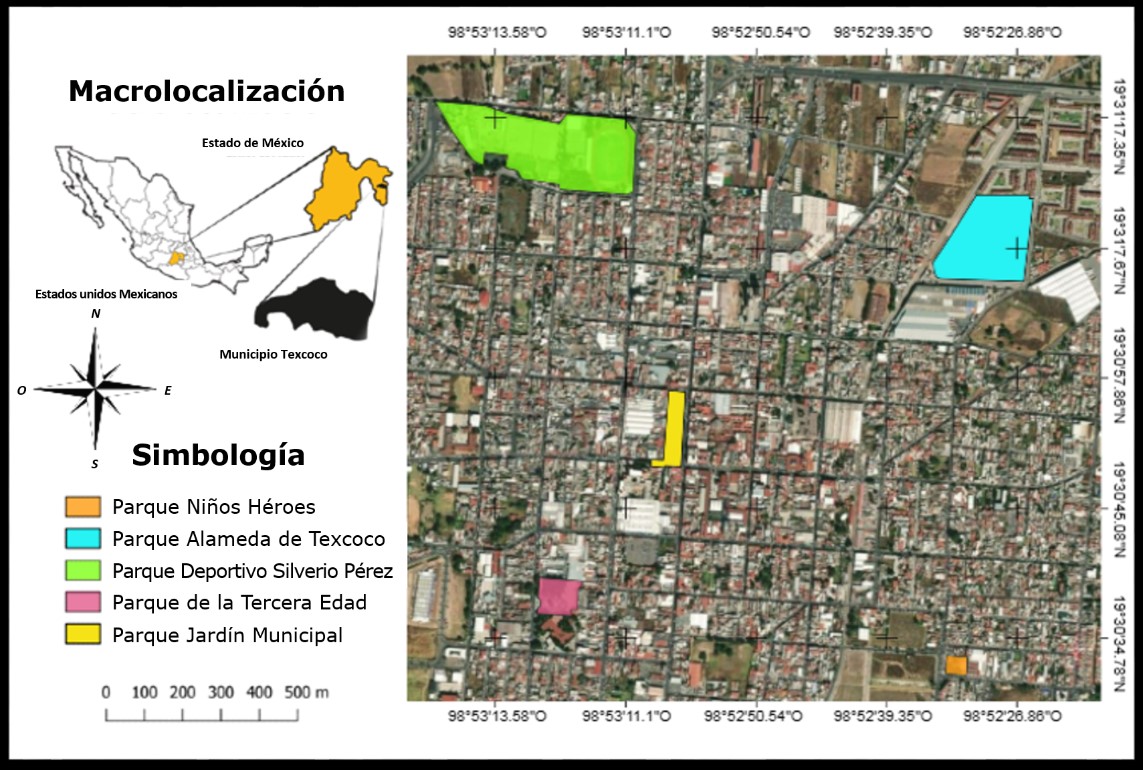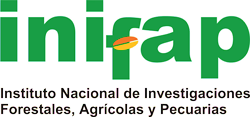Environmental services of tree vegetation of the parks of Texcoco de Mora, State of Mexico
DOI:
https://doi.org/10.29298/rmcf.v15i82.1452Keywords:
arboles urbanos, calidad de vida, cambio climático, captura de carbono, infraestructura verde, i-TreeAbstract
Urban trees play an important role within cities due to the environmental services they provide and their contribution to mitigating the current climate crisis. In this context, the objective of this study was to evaluate the tree vegetation of five public parks in the Texcoco de Mora municipality in order to estimate the environmental services they provide. A census was carried out per park and the data were processed through the i-Tree® Eco v6 software. 1 325 individuals from 23 families and 37 genera were recorded with a richness of 55 species in the five parks, an average density of 157 trees ha-1 and a total of 242.6 megagrams of carbon storage with a carbon capture of 10.5 Mg year-1. The avoided rain runoff was 481 m3 year-1 and the value represented by these environmental services is MXN $894 514.93 for carbon storage, MXN $38 650 annually for carbon capture, and MXN $481.93 for runoff. The replacement value of the trees reaches MXN $24 408 534. A tree cover of 30 485 m2 was estimated, which represents a factor of 0.86 m2 inhabitant-1. It is concluded that Texcoco is below the recommended factor of trees per inhabitant proposed by the UN. It is necessary to study the green areas, medians, alignment trees and community parks, to achieve a more complete panorama of the municipality.
Downloads
References
Almaguer H., S. N. 2006. La pérdida de la diversidad biológica: un problema de todos. LUZ 5(3):7-15. https://luz.uho.edu.cu/index.php/luz/article/view/256. (28 de agosto de 2023).
Arboreal. 2023. Arboreal®–Height of tree. https://www.arboreal.se/en/arboreal-forest. (20 de julio de 2023).
Badii, M. H., A. Guillen, C. E. Rodríguez, O. Lugo, J. Aguilar y M. Acuña. 2015. Pérdida de biodiversidad: causas y efectos. Daena: International Journal of Good Conscience 10(2):156-174. http://www.spentamexico.org/v10-n2/A10.10(2)156-174.pdf. (28 de agosto de 2023).
Bárcena, A., J. Samaniego, W. Peres y J. E. Alatorre. 2020. La emergencia del cambio climático en América Latina y el Caribe ¿Seguimos esperando la catástrofe o pasamos a la acción? Comisión Económica para América Latina y el Caribe (Cepal) y Organización de las Naciones Unidas (ONU). Santiago de Chile, RM, Chile. 375 p.
Calaza M., P. y M. I. Iglesias D. 2016. El riesgo del arbolado urbano. Contexto, concepto y evaluación. Mundi Prensa. Madrid, MD, España. 526 p. https://www.researchgate.net/publication/305210265_El_riesgo_del_arbolado_urbano_Contexto_concepto_y_evaluacion. (14 de julio de 2023).
De la Concha, H. 2018. ¡-Tree ECO-Sistema de información para mejorar el arbolado público. Revista Parques:28-32. https://www.itreetools.org/documents/210/RevistaParques_Sept-Nov2018_iTreeEco.pdf. (14 de enero de 2023).
Figueroa C., M. E. y L. A. Díaz-Galiano M. 2018. Los árboles urbanos y la salud ambiental. Revista oficial de la Asociación Española de Arboricultura 80:54-59. https://www.researchgate.net/publication/342563818_Los_arboles_urbanos_y_la_salud_ambiental. (15 de julio de 2023).
Food and Agriculture Organisation (FAO). 2022. Biodiversity. https://www.fao.org/ecosystem-services-biodiversity/background/regulatingservices/es/. (5 de agosto de 2023).
Giannotti, E., A. Vásquez y P. Velásquez. 2020. Policy Brief: Propuestas para un sistema de áreas verdes para ciudades sostenibles y saludables. Universidad de Chile. Santiago de Chile, RM, Chile. 10 p.
Hernández-López, P., T. Martínez-Trinidad, P. Hernández-de la Rosa, L. Mohedano-Caballero and M. de J. González G. 2023. Ecological characterization of trees at Molino de Flores Netzahualcóyotl National Park. Revista Chapingo Serie Ciencias Forestales y del Ambiente 29(3):93-108. Doi: 10.5154/r.rchscfa.2023.01.002. DOI: https://doi.org/10.5154/r.rchscfa.2023.01.002
Herrera C., V. M. y M. de L. Romo A. 2021. La distribución de las áreas verdes públicas en relación con las características socioeconómicas de la población en Ciudad Juárez, México. Acta universitaria 31:e3101. Doi: 10.15174/au.2021.3101. DOI: https://doi.org/10.15174/au.2021.3101
Instituto Nacional de Estadística y Geografía (Inegi). 2021. Principales resultados por localidad (ITER) del Censo de Población y Vivienda 2020. Datos oportunos. (MEX-INEGI.ESD2.01-CPV-2020). Inegi. https://www.inegi.org.mx/app/descarga/ficha.html?tit=325913&ag=0&f=csv. (6 de enero de 2023).
Instituto Nacional de Estadística y Geografía (Inegi). 2022. Espacio y datos de México. Sistemas de consulta. Inegi. https://www.inegi.org.mx/app/mapa/espacioydatos/default.aspx?ag=150990001. (10 de enero de 2023).
Intergovernmental Panel on Climate Change (IPCC). 2022. Climate Change 2022: Impacts, Adaptation and Vulnerability. Working Group II Contribution of to the Sixth Assessment Report of the Intergovernmental Panel on Climate Change. Cambridge University Press. Cambridge, CAM, United Kingdom. 3056 p. DOI: https://doi.org/10.1017/9781009325844
i-Tree. 2021. i-Tree® Eco User’s Manual Versión 6.0. United States Department of Agriculture. Whashington, D. C., United States of America. 93 p. https://www.itreetools.org/documents/275/EcoV6_UsersManual.2021.09.22.pdf. (10 de enero de 2023).
Li, X., C. Zhang, W. Li, R. Ricard, Q. Meng and W. Zhang. 2015. Assessing street-level urban greenery using Google Street View and a modified green view index. Urban Forestry & Urban Green 14(3):675-685. Doi: 10.1016/j.ufug.2015.06.006. DOI: https://doi.org/10.1016/j.ufug.2015.06.006
Lüttge, U. and M. Buckeridge. 2020. Trees: structure and function and the challenges of urbanization. Trees 37:9-16. Doi: 10.1007/s00468-020-01964-1. DOI: https://doi.org/10.1007/s00468-020-01964-1
Martínez-Soto, J., M. Montero y L.-L. y J. M. de la Roca C. 2016. Efectos psicoambientales de las áreas verdes en la salud mental. Interamerican Journal of Psychology 50(2):204-214. https://www.redalyc.org/pdf/284/28447010004.pdf. (15 de enero de 2023).
Martínez-Trinidad, T., P. Hernández L., S. F. López-López y L. Mohedano C. 2021. Diversidad, estructura y servicios ecosistémicos del arbolado en cuatro parques de Texcoco mediante i-Tree Eco. Revista Mexicana de Ciencias Forestales 12(67):202-223. Doi: 10.29298/rmcf.v12i67.880. DOI: https://doi.org/10.29298/rmcf.v12i67.880
Organización de las Naciones Unidas (ONU). 2015. Habitat III 11-Espacio público. ONU. Nueva York, NY, Estados Unidos de América. 8 p. https://habitat3.org/wp-content/uploads/Issue-Paper-11_Public_Space-SP.pdf. (11 de enero de 2023).
Organización de las Naciones Unidas para la Alimentación y la Agricultura (ONUAA). 2021. Los bosques para la salud y el bienestar de los seres humanos. Fortalecimiento del nexo entre los bosques, la salud y la nutrición. ONUAA. Roma, RM, Italia. 81 p.
Quiroz B., D. E. 2018. Implementación de infraestructura verde como estrategia para la mitigación y adaptación al cambio climático en ciudades mexicanas, hoja de ruta. Secretaria de Desarrollo Agrario, Territorial y Urbano (Sedatu), Secretaría de Medio Ambiente y Recursos Naturales (Semarnat) y Gesellschaft für Internationale Zusammenarbeit (GIZ). Coyoacán, Cd. Mx., México. 69 p. https://www.gob.mx/cms/uploads/attachment/file/394115/Hoja_de_ruta_IV_Infraestructura_Verde.pdf. (11 de enero de 2023).
Rodríguez, J. P. 2001. La amenaza de las especies exóticas para la conservación de la biodiversidad suramericana. Interciencia 26(10):479-483. https://www.redalyc.org/articulo.oa?id=33906110. (14 de julio de 2023).
Secretaría de Agricultura y Desarrollo Rural (Sader). 2020. Los árboles como fuente de vida indispensable. https://www.gob.mx/agricultura/articulos/los-arboles-como-fuente-de-vida-indispensable. (14 de agosto de 2023).
Seiferling, I., N. Naik, C. Ratti and R. Proulx. 2017. Green streets—Quantifying and mapping urban trees with street-level imagery and computer vision. Landscape and Urban Planning 165:93-101. Doi: 10.1016/j.landurbplan.2017.05.010. DOI: https://doi.org/10.1016/j.landurbplan.2017.05.010
Zamora M., M. C. 2015. Cambio climático. Revista Mexicana de Ciencias Forestales 6(31):4-7. https://cienciasforestales.inifap.gob.mx/index.php/forestales/article/view/190. (25 de enero de 2023). DOI: https://doi.org/10.29298/rmcf.v6i27.276

Published
How to Cite
Issue
Section
License
Copyright (c) 2024 Revista Mexicana de Ciencias Forestales

This work is licensed under a Creative Commons Attribution-NonCommercial 4.0 International License.
The authors who publish in Revista Mexicana de Ciencias Forestales accept the following conditions:
In accordance with copyright laws, Revista Mexicana de Ciencias Forestales recognizes and respects the authors’ moral right and ownership of property rights which will be transferred to the journal for dissemination in open access.
All the texts published by Revista Mexicana de Ciencias Forestales –with no exception– are distributed under a Creative Commons License Attribution-NonCommercial 4.0 International (CC BY-NC 4.0), which allows third parties to use the publication as long as the work’s authorship and its first publication in this journal are mentioned
The author(s) can enter into independent and additional contractual agreements for the nonexclusive distribution of the version of the article published in Revista Mexicana de Ciencias Forestales (for example, include it into an institutional repository or publish it in a book) as long as it is clearly and explicitly indicated that the work was published for the first time in Revista Mexicana de Ciencias Forestales.
For all the above, the authors shall send the form of Letter-transfer of Property Rights for the first publication duly filled in and signed by the author(s). This form must be sent as a PDF file to: ciencia.forestal2@inifap.gob.mx
This work is licensed under a Creative Commons Attribution-Noncommercial 4.0 International license.





